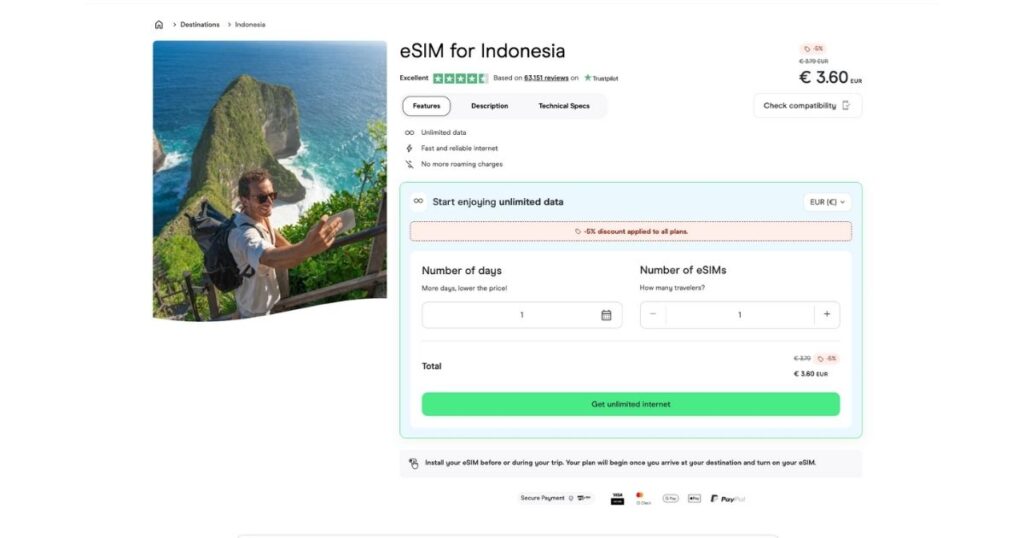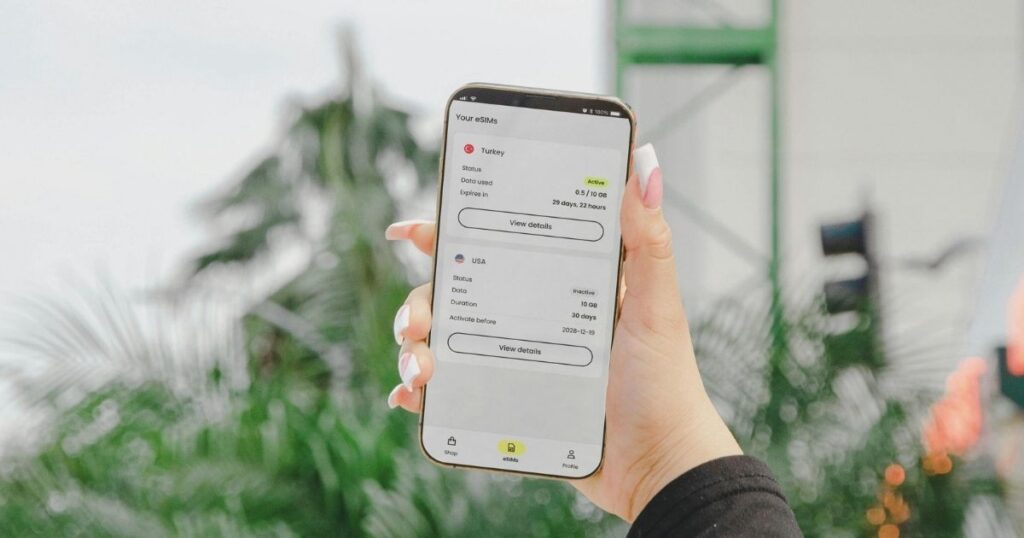Staying connected during your Bali adventure has never been easier thanks to eSIM technology, which eliminates the hassle of hunting for local SIM cards or dealing with expensive roaming charges. Whether you’re a digital nomad planning an extended stay in Canggu, a traveler exploring Ubud’s rice terraces, or a remote worker needing reliable internet for client calls, choosing the right eSIM for Bali ensures seamless connectivity throughout your Indonesian journey.
The tropical paradise of Bali presents unique connectivity challenges, from varying network coverage between tourist hotspots and remote areas to the need for reliable internet access in co-working spaces and beachside cafes. Understanding your options for eSIM in Bali helps you make informed decisions that keep you connected without breaking your travel budget.
This comprehensive guide explores the best eSIM providers, activation processes, and practical tips for maintaining optimal connectivity across Indonesia’s most beloved island destination.
Understanding eSIM technology for Bali travel

eSIM technology represents a revolutionary approach to mobile connectivity that’s particularly beneficial for international travelers visiting Indonesia. Unlike traditional physical SIM cards, an eSIM for Bali operates as a digital profile embedded directly in your device, allowing instant activation without physical card swapping.
💡 Did you know? Indonesia’s telecommunications infrastructure has rapidly modernized over the past decade, with major carriers now offering extensive 4G coverage across Bali and expanding 5G networks in urban areas like Denpasar and Ubud. This makes eSIM technology highly effective for travelers seeking reliable connectivity.
Key advantages and compatibility of eSIM in Bali
eSIM offers immediate activation upon arrival, eliminating the need to locate physical SIM card vendors or navigate language barriers. This proves particularly valuable when arriving at Ngurah Rai International Airport late at night or during busy tourist seasons.
The technology provides flexibility to switch between multiple carriers without physical card changes, while offering cost transparency with clear pricing structures and no hidden fees compared to traditional roaming charges.
Modern smartphones including iPhone XS and newer models, Samsung Galaxy S20 series and above, and Google Pixel 3 and later versions support eSIM functionality. Travelers should verify device compatibility and ensure their phone is unlocked before departure.
🌟 Pro tip: test your device’s eSIM functionality at home before traveling, as carrier-locked phones may restrict international eSIM activation, limiting your connectivity options in Bali’s diverse regions.
Top eSIM providers for Bali travel
Several reputable providers offer specialized eSIM solutions for Indonesian travel, each with distinct advantages depending on your specific needs, travel duration, and data requirements.
Holafly: unlimited data solution
Holafly stands out for Bali travelers seeking unlimited data without usage restrictions or speed throttling. Their seamless eSIM activation process provides instant connectivity upon arrival, making it ideal for digital nomads and heavy data users who need consistent internet access.
The provider offers excellent customer support in multiple languages, crucial when dealing with technical issues while traveling. Their straightforward pricing eliminates surprise charges, while coverage includes major tourist areas, business districts, and transportation hubs across Indonesia.
Airalo: budget-friendly options
Airalo provides cost-effective eSIM solutions for budget-conscious travelers, offering various data packages tailored to different usage patterns and trip durations. Their Asia-Pacific regional plans include Indonesia coverage alongside neighboring countries.
The platform’s user-friendly app allows easy plan management, top-ups, and usage monitoring, providing transparency and control over connectivity expenses throughout your Bali stay.
Ubigi: extended stay coverage
Ubigi offers specialized Indonesia packages designed for extended stays, making it suitable for digital nomads planning comprehensive exploration of Bali and surrounding islands. Their competitive pricing for larger data allowances provides excellent value for substantial connectivity needs.
Choosing the right eSIM plan

Selecting an optimal eSIM in Bali requires careful consideration of your travel style, duration, data needs, and budget constraints to ensure seamless connectivity without overspending.
Data requirements assessment
Digital nomads and remote workers typically require 15-30GB monthly for video calls, file uploads, and cloud synchronization, while casual travelers may need only 3-10GB for navigation, social media, and communication.
Content creators should budget additional data for photo uploads and social media management, particularly when sharing high-resolution content from Bali’s photogenic locations.
Duration and budget planning
Short-term visitors (1-2 weeks) benefit from fixed-duration packages that provide sufficient data without complex renewal processes. Extended stays require plans offering renewal options or transition pathways to local carriers.
Budget eSIM plans start around $10-15 for basic data allowances, while premium unlimited options range from $40-80 for extended stays. Regional packages covering multiple Southeast Asian countries typically cost $25-50.
Activation process and setup
Successfully activating your eSIM for Bali requires preparation and understanding of the technical process to ensure smooth connectivity from arrival.
Pre-departure preparation
Purchase and download your eSIM profile before traveling to avoid connectivity issues or payment complications while abroad. Most providers offer instant delivery via email or app download.
Test the activation process in your home country to identify any technical issues or account problems that could complicate connectivity upon arrival in Bali.
Activation steps
Enable your eSIM profile immediately upon landing in Bali to begin network registration. This process typically takes 5-15 minutes, depending on network conditions.
Most providers offer QR code activation through simple scanning, though some require manual configuration through device settings. Initial testing should include speed checks and app functionality verification.
Network coverage and performance

Understanding Indonesia’s telecommunications landscape helps set realistic expectations for connectivity performance across different areas of Bali.
Coverage areas
Popular tourist areas, including Seminyak, Canggu, Ubud, and Sanur, offer excellent 4G coverage with emerging 5G availability in business districts and major hotels.
Rural areas, mountain regions, and remote beaches may experience reduced coverage or slower speeds, requiring offline preparation for navigation and communication needs.
Performance expectations
Download speeds in urban areas typically range from 20-100 Mbps, depending on network congestion, sufficient for most business and entertainment needs. Upload speeds, particularly important for content creators, may be more limited.
Connection stability generally meets international standards in tourist areas, though performance may vary during peak usage periods or network maintenance.
Cost analysis and practical tips
Understanding true costs and optimization strategies helps maximize your eSIM investment while ensuring adequate connectivity for your Bali experience.
Value optimization
Hidden costs, such as activation fees and speed throttling, can impact total expenses. Purchasing during promotional periods provides savings, while monitoring usage helps avoid overage charges.
Daily unlimited rates often provide better value than traditional roaming charges, particularly for business travelers or heavy data users requiring consistent connectivity.
Usage best practices
eSIM technology can impact battery life differently than physical SIM cards, requiring attention to power management settings. International data usage requires heightened security awareness, making VPN usage advisable.
Maintain backup connectivity options including local Wi-Fi access and emergency communication methods. Physical SIM card availability provides backup if eSIM encounters technical problems.
Final thoughts
Selecting the right eSIM for Bali significantly enhances your Indonesian travel experience by providing reliable, cost-effective connectivity that adapts to your specific needs. From digital nomads requiring unlimited data to casual travelers needing basic communication services, eSIM technology offers flexible solutions that eliminate traditional roaming concerns.
Success depends on careful provider selection, proper device preparation, and realistic expectations about network performance in different regions. The investment in quality connectivity pays dividends through enhanced safety, productivity, and overall travel enjoyment throughout your Indonesian adventure.
Ready to stay connected during your Indonesian adventure? Understanding eSIM options is just the beginning of optimizing your digital nomad toolkit. For comprehensive guidance on managing connectivity challenges while traveling, explore our detailed guide on eSIM troubleshooting to prepare for any technical issues you might encounter.
Let Nomada help you maintain seamless connectivity wherever your travels take you 🌴
Frequently asked questions about eSIM for Bali
The best eSIM for Bali depends on your specific needs and usage patterns. Holafly offers unlimited data plans ideal for heavy users and digital nomads, while Airalo provides budget-friendly options for casual travelers. Ubigi excels for extended stays with comprehensive Indonesian coverage. Consider your data requirements, trip duration, and budget when selecting a provider for optimal connectivity throughout your stay.
eSIM costs for Bali range from $10-15 for basic plans with limited data to $40-80 for unlimited options. Regional plans covering multiple Southeast Asian countries typically cost $25-50, providing excellent value for travelers planning broader exploration beyond Bali. Daily unlimited rates often provide better value than traditional roaming charges for business travelers and heavy data users.
While you can purchase and download your eSIM profile before traveling, activation typically occurs upon arrival in Bali when your device connects to local networks. Pre-purchasing ensures immediate connectivity and avoids potential payment complications while abroad. Testing the download process at home helps identify any technical issues before departure to Indonesia.
eSIM coverage in rural Bali areas varies significantly depending on your provider’s carrier partnerships and the specific location you’re visiting. Popular tourist areas offer excellent coverage, while remote beaches and mountain regions may experience reduced service. Quality eSIM providers partner with multiple Indonesian carriers to maximize coverage across different regions of the island for optimal connectivity.
Most modern devices support multiple eSIM profiles, though typically only one can be active at a time. This allows you to maintain your home country plan while adding a Bali eSIM, switching between them as needed. Dual SIM functionality enables simultaneous use but may impact battery life and requires careful data management to avoid unexpected charges.
Common eSIM issues include activation delays, network registration problems, or APN configuration needs. First, restart your device and verify the eSIM profile is properly installed and activated. Contact your provider’s customer support if problems persist, as they can assist with network troubleshooting and account verification. Having backup connectivity options provides security during technical difficulties while traveling in Indonesia.




